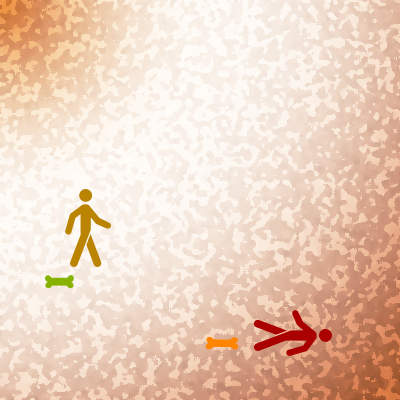In some of our IRC chats, Qvaak has asked me to go over demonstratives in Dothraki, so I’ll aim to do that today.
A demonstrative is a word like “this” that’s used in front of nouns or noun phrases. In English, we have these four common demonstratives:
- Give me this book. (Nearby, Singular)
- Give me that book. (Not Nearby, Singular)
- Give me these books. (Nearby, Plural)
- Give me those books. (Not Nearby, Plural)
Notice that the plural demonstratives above agree with the noun in plurality, but don’t actually mark plurality (i.e. you can’t say “Give me those book”). With that in mind, though, the English demonstratives encode two properties: number (singular vs. plural), and distance (nearby vs. not nearby).
In English, you may also use the demonstratives by themselves as demonstrative pronouns. They look just the same and can be used without nouns. The sentence above, then, would look like this:
- Give me this. (Nearby, Singular)
- Give me that. (Not Nearby, Singular)
- Give me these. (Nearby, Plural)
- Give me those. (Not Nearby, Plural)
Dothraki demonstratives, as modifiers, encode only one property: distance. Unlike English (but like many, many natural languages), Dothraki distinguishes three different distances: near to the speaker, near to the addressee, and near to neither. Demonstrative modifiers in Dothraki different from adjectival modifiers in that they precede the nouns they modify, rather than follow them. Using arakh instead of “book”, here are some sentences illustrating the distinctions made in Dothraki:
- Azhas anhaan jin arakh. “Give me this arakh.” (Near Speaker)
- Azhas anhaan haz arakh. “Give me that arakh.” (Near Addressee)
- Azhas anhaan rek arakh. “Give me that arakh.” (Near Neither)
Note that the form of the demonstrative doesn’t change regardless of the plurality of the the noun, as shown below:
- Anha tih rek hrakkares. “I saw that lion.”
- Anha tih rek hrakkaris. “I saw those lions.”
If you want to use the demonstratives by themselves as stand-alone pronouns, however, the forms do change, unlike in English. Basically, in order to use a demonstrative as a pronoun, one needs to know the animacy of the intended referent. The demonstrative then declines as a noun would that matched in animacy. The animate form for each demonstrative pronoun adds -ak to the end of the demonstrative in the nominative, and the inanimate adds an -i. The animate forms decline like any consonant-final animate noun, and the inanimate form declines like the relative pronoun fini (its declension is shown here). Below are some examples:
- Hazi zhokwae. “That (thing) is big.”
- Azhas rek anhaan. “Give that (thing) to me.”
- Azhas mae hazakaan. “Give it to that (one).”
- Jinak simon anni. “This is my uncle.”
Notice also the difference here between a copular phrase and a noun phrase:
- Jini havzi. “This is a cat.”
- jin havzi “this cat”
Regarding when to use which demonstrative, it’s fairly straightforward, given a specific circumstance. Let’s say we had two nameless interlocutors in a bizarre, Photoshop-esque landscape with multi-colored bones, as shown below:
Let’s take our speaker as the dark red dude. If he wants to refer to the orange bone, he says jin tolorro. If he wants to refer to the green bone, he says haz tolorro. If he wants to refer to the blue bone, he says rek tolorro. Simple enough. Now let’s look at a different scenario:
In this scenario, if the speaker is still the red dude and the addressee is still the yellow dude, the same exact demonstratives are used as were used in the previous example (jin for orange; haz for green; rek for blue). If his addressee is the pinkish dude, though, you’d use haz for blue and rek for green. The choice will be determined by who’s being spoken to, not how close the thing is to the speaker, necessarily.
Now how about if the red dude is speaking to both of those other dudes at the same time. In that instance, you’d use haz for both and point or further specify with words if necessary. Since both addressees are being addressed at once, anything that’s near either of them will be considered close enough to warrant haz.
Now let’s throw in a further wrinkle:
A new light blue bone has fallen from the sky! Let’s say that the red dude is addressing the yellow dude and the pink dude is just there. In this case, the red dude will refer to both blue bones with rek. The reason is that the green bone is still present. As it’s the closest to the addressee, it will get haz. This leaves rek to handle both of the bones that are further away, and the speaker will have to further specify if further specification is required.
Now how about this scenario:
Now the red dude is thinking about the light blue bone from the last picture. In this case, the red dude refers to the light blue bone with rek. Presumably he could only do so if the light blue bone was known to both he and the yellow dude (otherwise he would need to introduce it into the discourse), but once it’s a part of the shared experience of speaker and addressee, it can be referred to with a demonstrative. As the addressee has a bone that’s near at hand (the green bone), it gets haz, leaving rek for the light blue bone.
Now how about this scenario:
Yellow dude was out for his morning ride (around the green bone like every morning), when he sees that his friend red dude is lying on the ground in distress. He dismounts and walks past the green bone to get a closer look. Red dude, for whatever reason, has been incapacitated, and, as he gurgles out, the only thing that will save him is the orange bone that’s relatively near at hand. What the red dude does, then, is refers to the orange bone with haz, rather than jin, in order to imply to the yellow dude that the orange bone is not, in fact, nearby. Though it may be physically quite close, in this instance, it’s further than his body will take him, and so he uses haz to indicate that. If he were to refer to the green bone for any reason, then, he’d use rek, even though it’s quite close to the addressee.
This kind of gives you an idea how to choose between the three demonstratives of Dothraki. This same schema applies to non-physical elements, such as discourse topics. So, for example, if a speaker has an idea about something, he may refer to that idea with jin (as it’s a produce of the speaker’s imagination, the idea is, metaphorically speaking, near at hand). An idea that an addressee has come up with, then, can be referred to with haz. Something that’s to be introduced to the discourse (which is, perhaps, the product of neither speaker nor addressee) can be referred to with rek.
In addition, due to the nature of this spatial metaphor, a Dothraki can actually give opinions about another’s idea by using a different demonstrative. So, for example:
- Hazi dirge davra! “That’s a good idea!”
- Reki dirge toki! “That’s a stupid idea!”
Both ideas are the product of the same person, but by using reki in the second sentence, the speaker has attempted to place the idea even further out of the discourse space, making it seem bizarre (and, thereby, unacceptable). And, of course, a speaker can take that the other way, using jin to make it seem like they had something to do with the idea, even though someone else came up with it.
As this post is getting a bit long, I’m going to cut it off here, but it’s a start! Consider this an introduction to deixis in Dothraki. More will follow in future posts.





Whee-o. That’s a whole lot of new information and clarification. Gotta rewrite the demostrative section on the wiki.
The adressee stuff was all new to me, I thought haz was just mid-distance pronoun for things “here”, but not at hand. Makes a lot of sense, though.
How much is the switch from person pronouns to demonstratives dependent of culture and language? It seems to me in Finnish often se, “it”, is used when English use that. Anything unexpected to be expected on that front, Dothraki-wise?
—
So, to recap on the wider topic of pronouns..
Person pronouns are I guess pretty well understood, possessives, shafka and all.
– some further details, like reflexive and reciprocal are still mystery
Demonstratives should now be quite nicely at grasp too.
We probably lack some indefinite pronouns, but I’d expect little to no surprises from them, and they also don’t seem that instrumental to general understanding of the language.
Relative pronoun stuff (save for the indefinite thingie) is explained and understood.
Interrogative pronouns is still a bit foggy issue. As is the whole topic of questions.
It seems some stuff can be easily confused with interrogatives and demonstratives. Relative pronouns for one (though they are luckily already discussed), but there seem to be other dependent clauses that (<- ha!) can cause confusion. Anything else?
There's also an ocean of pro-form stuff that us laymen have hard time distinguishing from pronouns. We've met pro-forms of prepositions, and I think that's easy enough to deal with, but pro-adverb stuff seems to be potentially quite messy: deixis, declination, specific uses like interrogatives…
“That” in English is too polysemous for me to parse this. Which “that” do you mean? Can you give me some examples from Finnish? I’d love to learn more Finnish!
Nevermind. My native language just confuses me. Having thought and read some more, Finnish 3rd person not-person-version pronouns (in informal modern speak the person-version is almost obsolete, so just as with Dothraki me, it’s the 3rd person pronoun, really) seems to double as approximately haz-equivalent demonstrative, even demonstrative modifier.
Where is he from? -> Mistä se on kotoisin? (Formally and in proper writing “Mistä hän on kotoisin?”)
What was that? (noise; not something pointed at) -> Mikä se oli?
Give me that book! (adressee is holding the book, no need to point) -> Anna se kirja!
etc.
If I may put on my prognosticator’s hat and venture a guess, I’d say that se is, in fact, becoming a predicate marker. Consider the following from Tok Pisin:
You can see where these words actually came from and see what’s happening. The third person pronoun is now em (from “him”), but this thing i actually came from “he”. It started out as a resumptive pronoun in phrases like the first one (we say it English, too: “This guy I met, he…”), and now it obligatorily sets off all third person arguments from the rest of the predicate. The next step will be for i to move into first and second person subject phrases (which it doesn’t yet do), and then it will be a full on predicate marker. Perhaps se is going the same root, but it’s just not there yet.
Also, with pronouns, it’s actually quite common for demonstratives to become third person pronouns (as happened from Latin to the Romance languages—and you can also see a bit of this in Turkish). It’s not surprising, then, if in the in between stages, the pronoun acts a little bit like a demonstrative.
Jin nesikh davralat This is very useful and helpful information. Keep up the good work!
One question though. You posted this example:
Anha tih rek hrakkares. “I saw that lion.”
Anha tih rek hrakkaris. “I saw those lions.”
The plural endings you have on ‘Hrakkar are those of animate nouns. Yet ‘Hrakkar is marked in the dictionary as inanimate. What is going on here? Or did I miss something?
There’s a mistake in the dictionary? Hrakkar is (and always has been) animate.
I remember asking you about the animacy of Hrakkar at Worldcon. You replied that you thought it was inanimate, but you were going to check. It does not follow any of the general rules for determining whether a noun is animate or inanimate (does this have something to do with the fact that it is a GRRM word?). In both the wiki and the dictionary, it is simply marked as n, and this marking predates my time as dictionary keeper. So, since it seems safer to assume that a noun with unknown animacy is inanamate, I have always treated it as such. I will gladly change it, though
It is safer to assume that a noun is inanimate (they are more numerous), but hrakkar does pass the key animacy test: It’s animate. That is, it’s alive and can run around. That’s usually step one in determining a noun’s animacy. (Well, actually step one would be to see if it has any affixes that are definitely animate/inanimate, but still.)